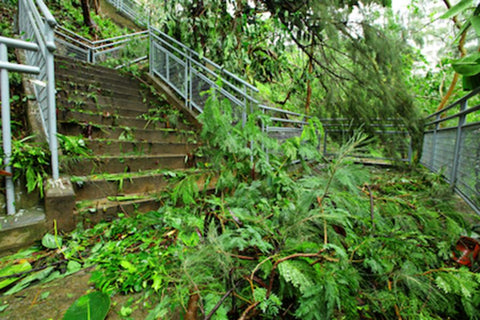
How did you fare after the whopping storms on the weekend? We are now once again looking down the barrel of extreme weather during the coming summer months, including heat, humidity and aggressive storms which can cause extensive damage to your home and garden.
In the aftermath of a storm like the one we endured over the weekend, yards are often covered with fallen trees, broken branches and scattered debris, leaving a giant mess for homeowners to clean up.
The moisture and heat also create the perfect conditions for weeds to take over.
Post-storm clean-up can present some risks, depending on how much damage your garden sustained, so it's important to take care as you get your yard back to normal.
Here are some clean-up and safety tips to help you clean-up your yard after the storm subsides
- Check the area: Walk around your property to inspect overall damage and take pictures as documentation.
- Check overhead for downed power lines and hanging branches.
- Never touch a power line that appears to be down or hanging.
- Instead, call your power company immediately to report the problem.
- Wear protective gear: Eliminate injuries by dressing appropriately and using protective eyewear and durable gloves.
- Protective footwear is also important.
- Repair trees: Damage can increase a tree's susceptibility to insects and diseases.
- If trees show signs of damage, they should be properly treated to maintain their health.
- Pruning damaged branches can help restore the tree.
- You should also remove broken and hanging branches to ensure safety, plus prevent additional property damage.
- Use the experts: More serious damage to trees should be treated by a tree specialist.
- This is especially important if extensive removal of large branches is required.
- As always, never try to remove branches or trees from utility lines.
- Let the professionals do it.
- Waste disposal: Materials from fallen or salvaged trees can be used in several ways.
- The larger branches can be cut and used for firewood, while smaller branches and twigs can be used as kindling or added to the compost pile.
- Replace plants and trees: Following yard clean-up, you may wish to make some new plantings.
- To help reduce future problems, make sure the plants being considered are hardy enough for the area.
- For trees, it is helpful to know the approximate size and shape of the tree when mature.
- This will help determine where to plant it to avoid interference with utility lines or branches rubbing against buildings.
- Repair paths/ driveways: Washout is particularly common following heavy rain.
- Repairing your driveway properly will help to prevent future wash outs.
- This is a quick guide to getting the job done properly the first time.
- Weed and Mulch: While the ground is still nice and damp, take the opportunity to pull out weeds (they should come away as easy as), and apply a generous layer of mulch to garden beds.
A thorough cleanup after the storm is also a great opportunity to prevent more damage when the next storm hits.





